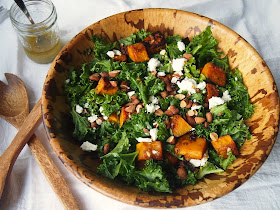I spent last week whining and complaining about the start of fall, even comparing my feelings on the changing seasons to the five stages of grief. Melodramatic? Yes. Accurate? Also yes, or, at least when I wrote it.
But now, I take it all back. Every last word. Because I have discovered my pumpkin spice latte. My Frye boots. The food equivalent of fall leaves crunching beneath my feet.
I am now a card carrying member of the kabocha squash club.
Each fall, I would run across posts by other bloggers whose enthusiasm for kabocha squash would jump off the computer screen. OMG and exclamation marks were used ad nauseam. Clearly, there was something special to this little squash.
But, as with many things in life, pure laziness kept me from trying kabocha earlier. With all those bumps and creases, you know peeling is gonna be a bitch. Butternut squash, with it's aerodynamic design, always was the easy choice.
When I learned kabocha's peel is edible, it was game on. Not only that, but by eating this skin, it ups the fiber content and you get more antioxidants, which like to hang out there.
Now, how can I explain kabocha's superiority to every other winter squash? Or, to every other food in general? Kabocha has the sweetest flavor of any winter squash. So I was surprised to learn it has one of the lowest calorie and carbohydrate contents of all the winter squash. In fact, kabocha has half the carbohydrate content of butternut...not that I'm counting carbs, but it's a good bit of knowledge for those who do. The texture was my favorite thing about it though - creamy, dense, and moist, it's often compared to the texture of roasted chestnuts. Honestly, I could see eating roasted kabocha in lieu of dessert, and I swear I haven't lost my mind!
As most people know, brightly colored fruits and veggies are the most nutrient-dense, so once you see kabocha's deep green skin and bright orange flesh, you'll know this bad boy is a powerhouse of nutrition. Kabocha, and other winter squash, are most known for their carotenoid content, a type of antioxidant that offers protection against cancer, heart disease and age related macular degeneration. Other antioxidants found in kabocha include vitamin C, phenols and even polysaccharides found in the cell wall.
This salad is perfect for the summer to fall transition, although I suppose this year we kind of skipped that phase. As simple as this salad is, it really hits all the different flavors and textures - creamy and crunchy, sweet and smoky and spicy and citrusy. Even better, this salad keeps in the fridge up to five days, even fully dressed. The squash will lose a little bit of it's just-out-of-the-oven crispness, but it soaks up a little bit of the lime juice from the dressing which is pretty delicious. Do make sure to massage the dressing into the kale, which softens the leaves and keeps them from being too tough.
Chipotle Roasted Kabocha and Kale Salad
Serves 4Squash adapted from The Food Matters Cookbook by Mark Bittman (highly recommend this cookbook for anyone just starting a plant based diet)
1 3-lb kabocha squash, seeded and cut into 1-inch cubes
4 tablespoons extra-virgin olive oil, divided
1 canned chipotle chili, chopped, with 2 tablespoons adobo sauce
3 cloves garlic, minced
1 tablespoon honey
1/2 cup almonds, roughly chopped
1 large lime, juice and zest
10 ounces kale, thick stems removed, roughly chopped
2 ounces crumbled feta (optional)
Preheat oven to 400 degrees.
In a large bowl, whisk together 2 tablespoons olive oil, chipotle chili, adobo sauce, garlic, and honey. Season with salt and pepper. Add squash and toss to combine. Spread evenly on a large baking sheet, leaving plenty of room between each piece so it doesn't steam. Bake for 30-45 minutes until tender and browned, flipping halfway.
While squash is roasting, toast the almonds. I put mine in a small baking dish in the toaster oven, checking frequently to make sure they don't burn, or you could toast them in a small, dry skillet over medium-high heat.
Next, make the dressing. Whisk remaining 2 tablespoons olive oil with lime juice and zest. Season with salt and pepper
When squash is done roasting, place kale in a large salad bowl. Drizzle with a little bit of the dressing. Massage the dressing into the leaves with your hands, which softens the kale. Add warm squash, almonds and feta. Serve with more dressing.



that's a gorgeous salad. I'm pinning it now. Can't wait to try it :)
ReplyDeleteThanks Liz! I hope you enjoy it!
DeleteI've been a huge fan of kabocha since..oh I don't know elementary years? Kabocha is actually a huge part of Korean diet. We're obsessed with it. This salad has all the flavors that I adore, and I actually have all the ingredients on hand! Pinning. Beautiful photos too, my friend ;)
ReplyDeleteThanks Min!! I knew Kabocha was a Japanese squash but I didn't realize it was such a big part of the Korean diet. Although, now that I've read this, I'm wondering if that's what they used to make this AMAZING Korean soup I had. Hope you enjoy it!
DeleteBeautiful salad! Looks so yummy too. Pinned it :)
ReplyDeleteThanks for sharing Karli!
Delete